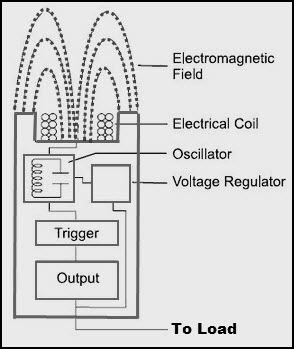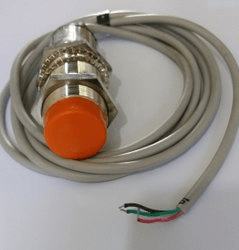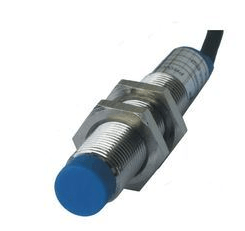The advancements in technology have shown the invention of multiple devices and tools in the engineering and science domain. And the one device which ruled many industries and domains is the “sensor”. The progression of a sensor started in the year 1860 and has no end. We observe multiple kinds of sensors in our day-to-day life such as pressure sensors, temperature sensors, and many others. The one which we are going to discuss today is on “Proximity Sensor”. This article describes the definition of proximity sensors, their working principle, advantages, types, and other features related.
What is Proximity Sensor?
Definition: The foremost operation of the proximity sensor is to find out the objects which have no physical contact. The finding of an object through the proximity shows the outcome as the starting of a corresponding activity. The activity which got initiated after the object detection is stated to be pre-specified. There are multiple methodologies used for the detection of things through the proximity sensors. The principal thing is that these sensors don’t require any kind of physical contact with that of sensors, so these are also termed as non-contact sensors. The proximity sensor circuit diagram is given by:

Circuit Diagram
Features
Some of the unique features that are present in the proximity sensors are:
- These are impervious to the surface conditions
- Can be applied either in damp or increased temperatures
- These devices provide enhanced response rates than that of general kinds of switches
- These have contactless sensing which means that the device can detect the object even when there is no physical contact between the two.
Different Types
Proximity sensors are categorized as many types and the categorization is based on the type of detection such as an object or atmospheric condition. And the foremost type to be discussed are
- Capacitive
- Inductive
Capacitive Proximity Sensor
These devices use the changes in the capacitance values of the sensor to detect the object. The procedure used for detection through this device is so streamlined where the sensor performs acts as the discrete plate in the device and the object which has to be detector either performs as a voltage source or the other plate. Between the plates, air acts as the dielectric material. When the object moves into the dielectric material, then there will be a change in the capacitor value and this variation is considered as recognition of the object.

Capacitive Proximity Sensor
The capacitive proximity sensor working principle can be explained as follows:
The variation of capacitance values is based on the distance, size, and magnitude of the detecting object. A general capacitive sensor is constructed with two parallel plates and needs to find the capacities of these two plates. The one plate is the sensor’s detecting edge and the other is a detected object. The variations in the capacity value developed in between these plates are known and an object is known.
Inductive Proximity Sensor
These devices use the changes in the inductance values of the sensor to detect the object. These tools are mostly utilized with metallic devices. When there is a current variation, the inductance and capacitance values are also changed. This variation in inductance value directs that the object was detected. Through inductance proximity sensors, objects which have non-conductive features cannot be found.

Inductive Proximity Sensor
The inductive proximity sensor working principle can be explained as follows:
These devices identify the magnetic loss which happens because of eddy currents which are developed on the conductive edge through the peripheral magnetic field. An alternating current magnetic field develops on the coil that has to be detected and variations in the impedance values because of eddy currents developed on the metallic device are identified.
The other techniques of detecting an object through proximity sensors are:
- Aluminum – detecting sensors – To identify the phase factor of the frequency.
- All-metal sensor – Using an operating coil, only the varied factor of the impedance is found.
- Pulse-response Sensors – These devices develop eddy currents and identify the time variation in the eddy current in correspondence to the voltage produced inside the coil.
Proximity Sensor Circuit Operating Voltages
Proximity sensors are constructed to function for hundreds of cycles. The factor that decreases the internal contact life is contact arcing. Maximum voltage levels lead to the development of arcing. So, the lessen the contact arcing, it is possible to choose the sensor with correct operating voltage levels. Generally, for direct current the voltage ranges between 10V – 320V and for alternating current, the voltage ranges between 20V – 265V.
Sensor Wiring
The proximity sensor circuit wiring conditions are depended on the following conditions:
NPN
For the NPN output, the load is positioned in between the output wire and the positive power source. In the ‘ON condition’ of the switch output, the current flow will be from load to ground via the output. This is termed to be negative switching.
PNP
For the NPN output, the load is positioned in between the output wire and the common source. In the ‘ON condition’ of the switch output, the current flow will be from the output of a device to the ground via the load. This is termed to be positive switching.
Normally Open
This is the wiring condition that when the output switch is ‘OPEN’, it obstructs the flow of current in the absence of actuator and when the output switch is ‘CLOSED, it allows the flow of current in the presence of actuator.
Normally Closed
This is the wiring condition that when the output switch is ‘CLOSED, it obstructs the flow of current in the absence of actuator and when the output switch is ‘OPEN, it allows the flow of current in the presence of actuator.
Proximity Sensor Circuit-Target Size
A standard sensor target has the dimensions of thickness 1mm constructed with mild steel material and having flat materials surface. Steel materials are of multiple types, whereas mild steel is the one which is the combination of iron and carbon materials. Here, the target (shielded sensors) side dimensions and the sensing direction diameter dimensions are equal. And the target (unshielded sensors) side dimensions are either similar to sensing direction diameter or three times the specified functional range. Although, when the target size is more than the standard target size, sensing range values are similar. Whereas, when the target size is minimal than that of standard target size, then there will be a decrement in the sensing length. So, when the target size is less, it has to closer to the sensing device.
Applications
The proximity sensor circuit applications can be as:
- Used in automatic faucets
- Implemented in roller coasters
- These are used in the manufacturing lines of food storages and beverages
- For the touch screens which are in near proximity distance to the sensing direction
- Implemented in parking sensors
- Proximity sensors stand as fundamental for the development of various circuits such as accurate proximity detector
- Object inspection and counting
Know more about Analog Sensor.
FAQs
1). How many types of proximity sensors are there?
The basic classification of proximity sensors is inductive, ultrasonic, capacitance, and photoelectric.
2). What is the range of IR sensor?
It is a light-sensitive device that can operate up to the range of 850nm.
3). Who invented the proximity sensor?
The scientists behind the proximity sensor are Wilfried Gehl, Walter Pepperl, and Ludwig Fuchs.
4). What is a proximity sensor on a phone?
For face detection in mobiles, proximity sensors are used.
5). What is an optical proximity sensor?
It is the light source that is used for the detection of light.
As these are the devices installed in mobile phones these are most in demand. Furthermore, these have increased reliability and operating life, and less mechanical parts. As because of these advantages, proximity sensors are mostly preferred than that of other conventional sensors. The touch vulnerable switches might be employed through proximity sensor circuits and proximity sensor circuit is also utilized to construct metal detector robotic projects. With this basic and detailed information, know more about what are the projects and experiments in the proximity sensor?